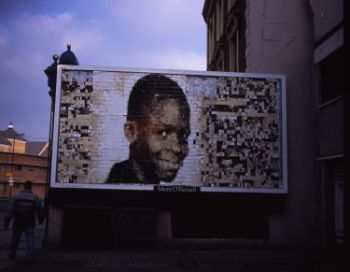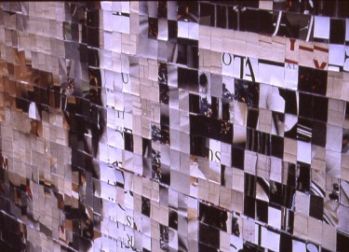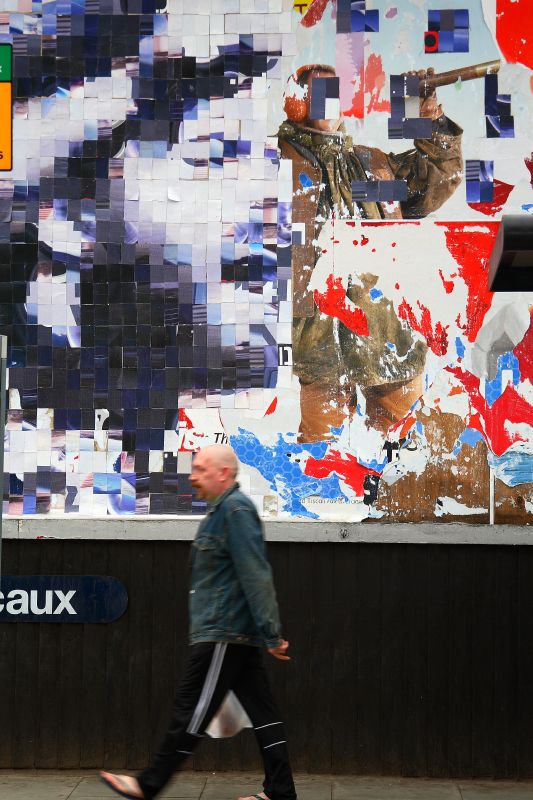Remix culture is closely associated with music since it derived from the musical remixes that emerged in the 60's and 70's. It is hard to pin-point the term to single definition, but generally speaking it is to do with interpreting pre-existing content and using it in combination with other content, to provide a fresh piece of material. In music, DJ's sample from pre-existing tracks, editing and adding to the material to create their own work, which may or may not carry the same ambience as the original music.
The introduction of the internet provided an efficient way of sharing and communicating ideas with others and enabled ideas to be broadcast online for free. With the development of the internet the culture of remix has been able to spread in new media. Classic examples can be found on youtube.com where video content is shared and viewed by millions of users.
Cut-up collective are an anonymous group of artists working in the realms of street art. They aim to highlight the creative potential of the street by sourcing their material from what is already out there. They believe that by recycling existent materials they can make more effective comments on it or challenge it. The group are known for taking existing advertising from the street, cutting it up and rearranging the pieces to create new images that are posted back up into the environments that they came from. Their aim is to disrupt the everyday experiences of passersby and to provoke discussion into the urban everyday and comment on ideas of creation formed from destruction, order from disorder and the potential for interruption that is inherent within the existing imagery of a modern metropolis.
Within their practice they encompass film, collage and installation.



In the video, 'RIP!: A remix manifesto', by Brett Gaylor, Fair Use is described as "a part of copyright law that allows for free speech."
This is backed up by 'Remix Culture: Fair Use is your Friend' by Center for Social Media which describes it as "a right"... "which protects the ability to create".
In other words, Fair Use is the section of the copyright code that preserves some right for the creativity of the public. It allows the use of copyrighted materials without permission of the creator of the work, but only under limited circumstances.
The situations where fair use applies include:
- Commenting critiquing,
- Illustration or example,
- Incidental Use,
- Cultural Rescue,
- Launching Discussion,
- Mashups,
R
E
I
M
X
Copyright is the set of rights that are given exclusively to the original author or creator of a work. It contains the right to copy, distribute and adapt the copyrighted material. No other person can access the same rights until they may obtain permission from the author. They may not reproduce or make copies of the protected work in any other medium without this permission.
Essentially, this provides the author or creator with legal protection over their work and a certain control over its distribution. It also provides them with the right to benefit from their intellectual efforts from the moment of creation. However copyright does not protect ideas, systems or factual information conveyed in the work.
Copy left is a form of licensing that permits the free use, distribution and modification of a work such as computer software. it is a play on the word 'Copyright' to describe the practice of copyright law. By contrast, the copyleft practice makes a work openly available without the need to obtain permission from the original authors. The conditions of this agreement say that anyone who redistributes the work, with or without changes, must pass along the freedom to further copy and change it. It guarantees that every user along the line, in connection with the licensed work, will have the same freedoms as the persons before them. It also means that no one should profit from any version of the work that was made available to them for free.
V
S
COPYRIGHT
COPYLEFT
Open Source
Peer Production
FAIR USE
open source
Codes of best practices in Fair Use have been developed in various communities, including the specific practice of 'online video'. They provide the guidelines for people to understand what is acceptable in their field so that they are aware of what the limitations are of their rights. It is helpful to figure the circumstances in which you are protected so that you can defend your rights against accusations.
c
u
t
u
p
Codes of Best Practice
fair use
creative commons
C
U
L
T
U
R
E
collective
define: REMIX CULTURE
remix culture
g
i
r
l
t
a
l
k
Girl talk is a remix artist who creates new music out thousands of music samples from existing popular tracks. Using his computer as his instrument he cuts up the existing songs and pastes small clips in a rhythmic. Girl talk
REMIX MANIFESTO
1. Culture always tries to build on the past.
2. The past always tries to control the future
3.